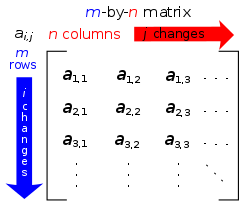行列(マトリクス)とは?定義・演算ルールと線形代数での応用を解説
行列の定義から足し算・掛け算のルール、線形代数やコンピュータ応用まで初心者にも分かる図解で徹底解説
数学では、行列(複数形:matrices)とは、行と列に配置された長方形の数字のことである。行はそれぞれ左から右へ(水平方向)の直線で、列は上から下へ(垂直方向)の直線である。左上のセルは1行目の1列目にあります(右図参照).
行列の足し算、引き算、掛け算のルールがあるが、数のルールとは違う。例えば、A ⇔B {\displaystyle A\cdot B

多くの自然科学では行列を多用している。多くの大学では、行列(通常は線形代数と呼ばれています)についての授業は非常に早く、時には初年度にも教えられています。行列はコンピュータサイエンスでもよく使われています。
基本的な定義と表記
行列は通常、m行n列の「m×n 行列」と表記され、各要素は aij(i行j列)で表されます。特に行が1つの行列は行ベクトル、列が1つの行列は列ベクトルと呼ばれます。行数と列数が等しい行列は正方行列といい、正方行列に対しては行列式や逆行列、固有値といった概念が定義されます。
基本演算とそのルール
- 加法・減法:同じ形(同じ行数・列数)の行列同士で定義され、対応する成分ごとに足し引きします。形が違えば加減算はできません。
- スカラー倍:実数や複素数などのスカラーcと行列Aについて、cAはAの全成分にcを掛けた行列です。
- 行列の積:Aがm×n、Bがn×pのときにのみ積AB(m×p)が定義され、その成分は (AB)ij = Σk=1..n AikBkj です。積は一般に可換でなく、AB ≠ BA となることが多いです(上の段落にあるように、数の掛け算とは振る舞いが異なります)。
- 転置:A の転置 AT は行と列を入れ替えた行列で、(AT)ij = Aji。対称行列(A = AT)や斜対称行列(AT = −A)などが重要です。
正方行列に特有の概念
単位行列Iは対角成分が1、その他が0の正方行列で、任意の同じサイズの行列Aに対して IA = AI = A を満たします。逆行列A−1は AA−1 = A−1A = I を満たす行列で、存在するための必要十分条件は det(A) ≠ 0(行列式が0でない)です。
行列式(det)は正方行列に対して定義されるスカラーで、行列が可逆かどうか、線形変換での体積の伸縮率などを表します。ランクは行列の独立な行(または列)の最大数で、線形独立性や方程式系の解の次元に直結します。
固有値・固有ベクトル
A v = λ v を満たす非ゼロベクトル v を A の固有ベクトル、対応するスカラー λ を固有値と呼びます。固有値は det(A − λI) = 0 を満たす λ で与えられる特性方程式の根です。固有値分解や特異値分解(SVD)は多くの応用で重要です。
線形代数での代表的な応用
- 連立一次方程式の解法:Ax = b の形で表される問題をガウス消去法やLU分解、QR分解などで解きます。
- 線形変換の表現:行列はベクトル空間上の線形変換を表します。変換の合成は行列の積に対応します。
- 固有値問題:振動問題、安定性解析、主成分分析(PCA)などで固有値・固有ベクトルが利用されます。
- コンピュータグラフィックス:座標変換(回転・拡大縮小・平行移動)は行列を使って効率よく扱えます。
- 機械学習・データ解析:データを行列で扱い、線形回帰、行列因子分解、畳み込みやニューラルネットワーク内部の計算で行列演算が中心になります。
- その他の応用:量子力学の状態ベクトルと演算子、ネットワークの隣接行列、統計の共分散行列など多方面で用いられます。
数値計算上の注意点
実際の計算では丸め誤差や計算コストが問題になります。大きな行列に対しては効率的なアルゴリズム(例えば反復法、SVD、特別な構造を利用した手法)や数値的安定性を考慮した実装が必要です。
まとめ(ポイント)
- 行列は数や変数を長方形に並べたもので、行・列の概念が基本。
- 加減算は同形同士、積は内側の次元が一致するときに定義。積は一般に可換ではない。
- 正方行列には逆行列、行列式、固有値といった特別な概念があり、線形代数の中心的対象。
- 応用範囲が広く、物理・工学・データ解析・コンピュータサイエンスなどで不可欠。

行列の特定の項目は,行と列のそれぞれの数値に対して,添え字のペアを使用して参照されることがよくあります.
定義と表記
行列の横線を行、縦線を列と呼びます。m行n列の行列をm×n行列(またはm×n行列)と呼び、mとnをその次元と呼びます。
行列の中で数字がある場所をエントリと呼びます.行列Aの行番号iと列番号jにあるエントリをAのi,jエントリと呼びます。 これをA[i,j]またはai,jと書きます。
A := ( a i j ) m × n {\displaystyle A:=(a_{ij})_{mtimes n}}}と書くことで、
例
行列
[ 1 2 3 1 2 7 4 9 2 6 1 5 ] ♪ ♪ ♪ ♪ ♪ ♪ ♪ ♪ ♪ ♪ ♪ ♪ ♪ ♪ ♪ ♪ ♪ ♪ ♪ ♪ ♪ ♪ ♪ ♪ ♪ ♪ ♪ ♪ ♪ ♪ ♪ ♪ ♪ ♪ ♪ ♪ ♪ ♪ ♪ ♪ ♪ ♪ ♪ ♪ ♪ ♪ ♪ ♪ ♪ ♪ ♪ ♪ ♪ ♪ ♪ ♪ ♪ ♪ ♪ ♪ ♪ ♪ ♪ ♪ ♪ ♪ ♪ ♪ ♪ ♪ ♪ ♪ ♪ ♪ ♪ ♪
は 4×3 の行列です。この行列は、m=4行、n=3列である。
要素a[2,3]またはa2,3が7である。
業務内容
追加
2つの行列の和は、(i,j)番目のエントリが2つの行列の(i,j)番目のエントリの和に等しい行列である。
1 3 2 1 0 0 1 2 2 ] + [ 0 0 5 7 5 0 2 1 1 ] = [ 1 + 0 3 + 0 2 + 5 1 + 7 0 + 5 0 + 0 1 + 2 + 1 2 + 1 ] = [ 1 3 7 8 5 0 3 3 3 ] { {displaystyle {begegin{bmatrix}1&&.3&2\\1&0&0\\1&2&2\end{bmatrix}}+{\begin{bmatrix}0&0&5\\7&5&0\\2&1&1\end{bmatrix}}={\begin{bmatrix}1+0&3+0&2+5\\1+7&0+5&0+0\\1+2&2+1&2+1\end{bmatrix}}={\begin{bmatrix}1&3&7\\8&5&0\\3&3&3\end{bmatrix}}}
2つの行列は同じ次元を持つ。ここで、A + B = B + A {\displaystyle A+B=B+A
2つの行列の掛け算
2つの行列の掛け算は少し複雑です。
( a 1 a 2 a 3 a 4 )・・・ [ b 1 b 2 b 3 b 4 ] = [ ( ( a 1 ⋅b 1 + a 2 ⋅b 3 ) ( a 1 ⋅b 2 + a 2 ⋅b 4 ) ( a 3 ⋅b 1 + a 4 ⋅b 3 ) ( a 3 ⋅b 2 + a 4 ⋅b 4 ) ] です。{\displaystyle {\begin{bmatrix}a1&a2\\a3&a4\\\end{bmatrix}}\cdot {\begin{bmatrix}b1&b2\\b3&b4\\\\\bmatrix}={begin{bmatrix}(a1\cdot b1+a2\cdot b3)&(a1\cdot b2+a2\cdot b4)A3\cdot b1+a4\cdot b3)&(a3\cdot b2+a4\cdot b4)A3\\\\bmatrix}={B4\\\\bmatrix}={B4\\\\\bmatrix}}={B4\\\\\bmatrix}}={B4\\\\bmatrix}={B4\\\bmatrix}={B4\\\\bmatrix
ナンバーズの場合もそうですね。
3&5&0\\\\\\\\\\\\\\\\\\\\\\\\\\\\\\\\\\\\\\\\\\\\\\\\\\\\\\\\\\\\\\\\\\\\\\\\\\\\\\\\cot.co.(1\cdot 3+4\cdot 0)\\\end{bmatrix}}={\begin{bmatrix}31&9\\22&3\\\end{bmatrix}}}
- 2つの行列は,1つ目の行列の列の数が2つ目の行列の行の数と等しい限り,次元が異なっていても互いに乗算することができます.
- 積と呼ばれる乗算の結果は,1番目の行列と同じ行数,2番目の行列と同じ列数の別の行列となります.
- 行列の掛け算は可換的ではないので、一般的には A ≠ B ≠ B ≠ A ≠ A ≠ A ≠ A
- 行列の掛け算は連想的なので、( A ⇔ B )⇔ C = A ⇔ ( B ⇔ C ) {\displaystyle (A\cdot B)C=A\cdot (B\cdot C)} となります。
特殊行列
特殊な行列があります。
正方行列
正方行列は行の数と列の数が同じなので、m=nとなります。
正方行列の例は
[ 5 - 2 4 0 9 1 - 7 6 8 ] {pos(100,000)} {pos(100,000)} {pos(100,000)} {pos(100,000)} {pos(100,000)} {pos(100,000)} {pos(100,000)} {pos(100,000)} {pos(100,000)}
この行列は3行3列:m=n=3です。
アイデンティティ
行列のすべての正方次元集合には,「同一性行列」と呼ばれる特別な対応関係がある.同一性行列は,主対角線上のすべての対角線を除いて,ゼロ以外のものは何もありません.例えば,次のようになります.
[ 1 0 0 0 0 1 0 0 0 1 ] {displaystyle {\begin{bmatrix}1&0&0&0&0\0&0&1&0\0&0&0&1} ♪ ♪ ♪ ♪ ♪ ♪ ♪ ♪ ♪ ♪ ♪ ♪ ♪ ♪ ♪ ♪ ♪ ♪ ♪ ♪ ♪ ♪ ♪ ♪
は同一性行列である.正方次元集合には,各正方次元集合に対して正確に 1 つの同一性行列が存在します.等値行列が特殊なのは,任意の行列に等値行列を乗算すると,結果が常に元の行列になり,変更がないからです.
逆行列
逆行列とは,別の行列と掛け合わされたときに,同一性行列と等しくなる行列のことです.例えば
♪ ♪ ♪ ♪ ♪ ♪ ♪ ♪ ♪ ♪ ♪ ♪ ♪ ♪ ♪ ♪ ♪ ♪ ♪ ♪ ♪ ♪ ♪ ♪ ♪ ♪ ♪ ♪ ♪ ♪ ♪ ♪ ♪ ♪ ♪ ♪ ♪ ♪ ♪ ♪ ♪ ♪ ♪ ♪ ♪ ♪ ♪ ♪ ♪ ♪ ♪ ♪ ♪ ♪ ♪ ♪ ♪ ♪ ♪ ♪ ♪ ♪ ♪ ♪ ♪ ♪ ♪ ♪ ♪ ♪ ♪ ♪ ♪ ♪ ♪ ♪ ♪ ♪ ♪ ♪ ♪ ♪ ♪ ♪ ♪7\\\end{bmatrix}}\cdot {\begin{bmatrix}7&-8\\-6&7\\\end{bmatrix}}={\begin{bmatrix}1&0\\0&1\\\end{bmatrix}}}
7 - 8 - 6 7 ] 

2x2行列の逆数の公式は、 [ x y z v ] {\displaystyle {\begin{bmatrix}x&y\\z&v\end{bmatrix}}}です。
( 1 d e t ) [ v - y - z x ] {\displaystyle ™left({\frac {1}{det}right}) {\begin{bmatrix}v&y\-z&xend{bmatrix}}}}}
ここで d e t {displaystyle det
x v - y z {displaystyle {xv-yz}}}
1列マトリクス
行列は,多くの行を持ち,1列しかないものを列ベクトルと呼びます.
決定要因
行列式は正方行列を取り,スカラーという単純な数を計算する.この数が何を意味するかを理解するには,行列の各列を取り,それをベクトルとして描けばよい.これらのベクトルによって描かれた平行四辺形には面積があり,これが行列式である.すべての2×2行列に対して、式は簡単です。 det ( [ a b c d ] ) = a d - b c {\displaystyle ゙\det ゙\left({\begin{bmatrix}a&b\c&d\end{bmatrix}right)=ad-bc}.
3x3の行列の場合、式はもっと複雑です。det ( [ a 1 b 1 c 1 a 2 b 2 c 2 a 3 b 3 c 3 ] ) = a 1 ( b 2 c 3 - c 2 b 3 ) - a 2 ( b 1 c 3 - c 1 b 3 ) + a 3 ( b 1 c 2 - c 1 b 2 ) {\displaystyle デト レフト({\begin{bmatrix}a_{1}&b_{1}&c_{1}\\a_{2}&b_{2}&c_{2}\\a_{3}&b_{3}&c_{3}\\\end{bmatrix}}\right)=a_{1}(b_{2}c_{3}-c_{2}b_{3})-a_{2}(b_{1}c_{3}-c_{1}b_{3})+a_{3}(b_{1}c_{2}-c_{1}b_{2})}
大きな行列の行列式のための簡単な公式はなく、多くのコンピュータプログラマーは、コンピュータに大きな行列式を素早く見つけさせる方法を研究しています。
行列式の性質
すべての決定論者が従う3つのルールがある。これらは
- 同一性行列の行列式は 1
- 行列の2つの行または2つの列が交換された場合,行列式は-1を乗算します.数学者はこれを交替と呼ぶ。
- ある行または列のすべての数に別の数nを掛けた場合、行列式はnを掛けたものとなる。また、ある行列Mが、2つの列の行列v 1 {\displaystyle v_{1}}
とv 2 {\displaystyle v_{2}}の和である列vを持つとすると
この2つの条件を多線性と呼ぶ。
も参照してください。
- 線形代数
- 数値線形代数
質問と回答
Q:行列とは何ですか?
A:行列とは、行と列に並べられた数値の長方形のことです。行はそれぞれ左から右(水平)線、列は上から下(垂直)に進みます。
Q:行列はどのように表現されるのですか?
A:行列は、A、B、Cのような大文字のローマ字で表現されることが多いです。
Q:2つの行列を掛け合わせるとどうなるのでしょうか?
A:積ABがBAと同じ結果になるとは限らないので、普通の数字の掛け算とは違います。
Q:行列は2つ以上の次元を持つことができますか?
A:はい、行列は3次元行列のように2次元以上の次元を持つことができます。また、1つの行や列のような1次元のものもあります。
Q:行列はどこで使われるのですか?
A:行列は、多くの自然科学、コンピュータサイエンス、工学、物理学、経済学、統計学で使用されています。
Q:大学ではいつ行列の講義をするのですか?
A:大学では、行列(通常、線形代数と呼ばれます)についての講義は、非常に早い時期(場合によっては1年目)に行われます。
Q:行列を足したり引いたりすることは可能ですか?
A:はい。行列の足し算と引き算のルールはありますが、普通の数のルールとは異なります。
百科事典を検索する












